
[Source:
Martin James]
Halwill Gallery 1: c Early 20th Century - 1931 junction_old23.jpg) An early 20th century view across Halwill station and yard. The vantage point is the hill to the north-west of the station. The hillside in the foreground was later cut back to allow construction of the Torrington bay platform. A point to note is the, then, shorter length of the up platform on the left. It was extended, presumably when the Torrington bay was constructed, but was to remain slightly shorter than the down platform opposite. A rake of goods wagons can be seen on the right but they are not necessarily all of LSWR ownership. LSWR wagon livery was a deep reddish-brown but photographic evidence suggests passenger-rated wagons, i.e. fitted with the continuous brake or at least through-piped, wore a variation of passenger stock livery. Not too much notice should be given to the cattle wagon at far right as the light areas on the bodyside may be the result of cleaning but these wagons were one type which was passenger-rated. A better example is the van seen beside the goods shed; it has a lighter coloured bufferbeam and under magnification can be seen to be vacuum piped. To the right of this van are two locomotives, the plume of steam indicating the position of that further back. The locomotive turntable is in the right background and largely out of sight in this view. The station platforms are oil-lit but the lamp on the tall lattice post at the end of the platform is curious. It may have been gas, produced somewhere on-site, but this is highly unlikely. More likely is that it was on oil lamp, either wick or paraffin/pressure, of the type which could be winched up and down to and from the casement although there is no obvious evidence of any equipment for this purpose, nor does there appear to be a ladder. If it was oil, then its effectiveness on such a tall post would have been non-existent. Later pictures show a similar lamp deeper within the goods yard but this was probably that seen here on the end of
the platform simply relocated. Copyright photo from John Alsop collection  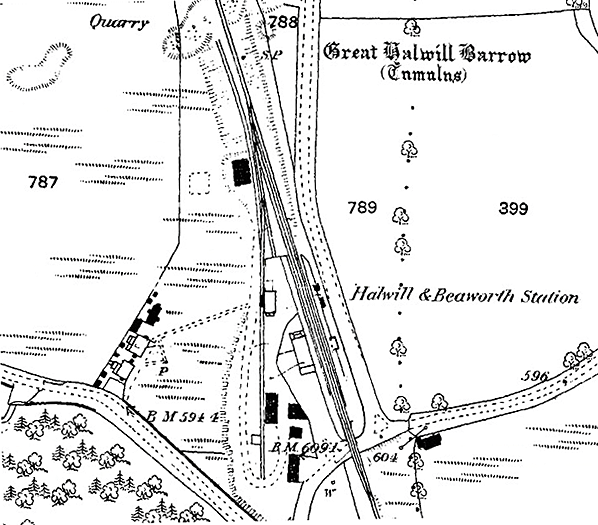
1885 1:2,500 OS map. When Halwill & Beaworth station opened it was just a wayside station and did not become a junction until 21 July 1886 when the North Cornwall Railway opened its first section to Launceston. The station is seen in its original form here. The line was single track with a passing loop at the station to allow for two platforms as seen here. The main station building is seen on the down side where there is a forecourt with a small waiting room opposite. The goods yard comprises one long siding which runs alongside a dock and then passes the goods shed. Another long siding trails in from the slaughterhouse to the north of the station. A number of other buildings are identified at the south end of the yard. A third short siding terminates end on to the dock. Although not identified as such, the building at the north end of the down platform is the original signal box. A terrace of railway cottages is seen to the west of the station; a footpath runs from the cottages to the goods yard.
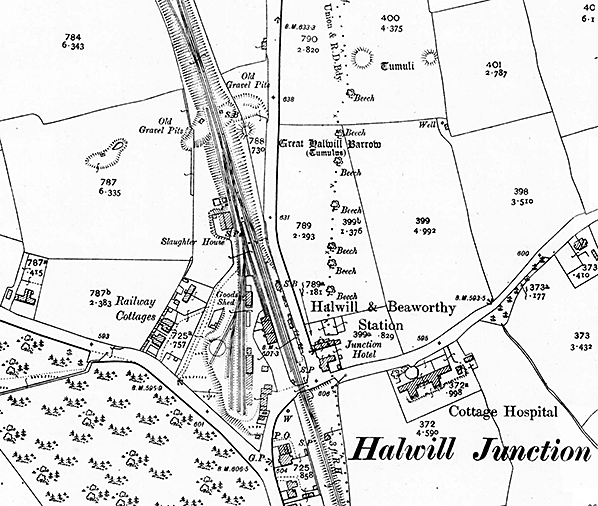
1906 1:2,500 OS map. With the arrival of the North Cornwall Railway Halwill became a junction station. Although the station name is now Halwill & Beaworthy the community that has built up around the station is itself called Halwill Junction. As well as new housing the community also includes the Junction Hotel, a post office and the Cottage Hospital. The station building on the down side has been replaced with a number of small buildings located on the up side. The signal box which has been rebuilt is now identified. A new bay platform for North Cornwall line trains has been provided at the rear of the down platform at its north end. The goods yard has been expanded with the addition of two more parallel sidings and a third short siding. A 50ft turntable has also been provided in the west side of the goods yard. The entrance to the yard is unclear. Other buildings close to the entrance were probably merchants' offices. Three water cranes are shown but not identified, two at the north end of the down platform and one at the south end of the up platform Click here for a larger version.
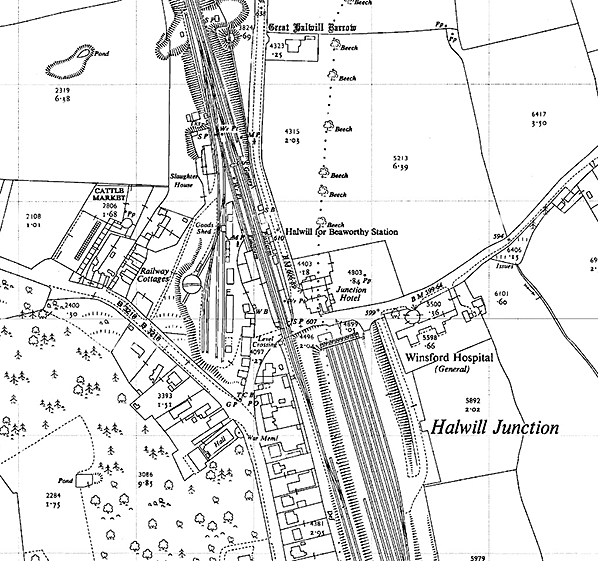 1954 1:2,500 OS map. The community of Hanwell Junction has continued to expand with some more housing, and a cattle market which has opened to the west of the goods yard. A second bay platform for Torrington trains is now seen beyond the north end of the up platform. The original LSWR slaughterhouse built by the LSWR was replaced with a larger structure by the Southern Railway in 1930. The entrance to the yard is now identified by a weighbridge (WM = weighing machine) located in the short station access road. The three water cranes (Wt Pt) are now identified. Eight sidings were built by the Southern Railway to the south of the station in 1943 to handle military traffic during the build-up to the Normandy landings. Click here for a larger version.
junction_old26.jpg) Another early twentieth century view of Halwill looking, left foreground, at the site of what was to become the Torrington bay platform. When compared to other similar early twentieth century views one difference is apparent here; the tall lattice post lamp on the end of the down/bay platform has disappeared. It is suspected of being relocated into the goods yard but its location there is hidden, in this view, by the pitched-roof slaughterhouse on the right. The slaughterhouse was rebuilt by the Southern Railway in 1930. At far right can be seen the rarely-photographed water tower. This supplied water to the water columns on the platforms; there are two in this view but there were later three. Just beyond the goods shed a locomotive stands while a train waits in the bay platform. In both cases the locomotives cannot be identified. This and other elevated views looking in the same direction illustrate well the gradient between Halwill and Ashbury, the next station along the line to Meldon Junction. It was this gradient which was responsible for the 1905 accident and partly responsible for the 1944 accident, both being briefly described below. Note the large and irregularly shaped dock with one siding terminating end-on. Copyright photo from John Alsop collection 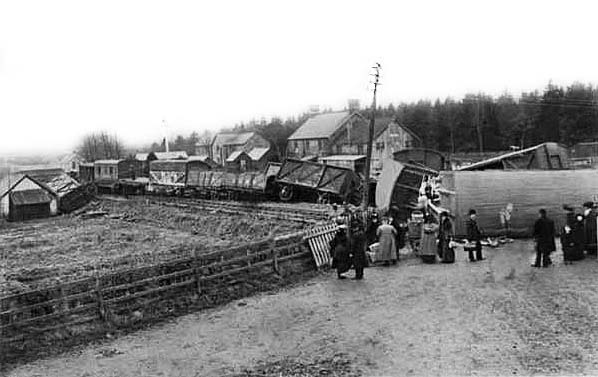 The quiet rural location of Halwill station was witness to a number of serious accidents. One occurred on 6 February 1905 and two in 1944 during the Second World War. These two photographs show the wreckage of the 1905 accident. A goods train approaching Halwill from Ashbury, on the Okehampton line, became divided on the downward gradient approaching Halwill. This was probably the result of snatching couplings which, at that time on the LSWR, were quite feeble and eventually the heavier GWR type became standard. Part of the job of a goods train guard included applying the brake in his van to assist the slowing of goods trains which were wholly or partially unfitted (not fitted with the continuous brake) depending upon the types of wagon and also to keep couplings taut for the very reason of preventing snatching. As the front portion of the 1905 train approached Halwill it slowed and, on reaching the level crossing the out-of-control rear portion, rammed into its rear. The guard, in his van at the rear of the runaway portion, would have been able to do little to prevent the collision. The result was the death of a number of pigs, injuries to two railwaymen and 25 damaged or wrecked wagons. The locomotive involved is not known. The subsequent report on this accident is now held at the National Archive. Details of the 1944 accidents are vague, probably because of conditions prevailing at the time.
Photo from John Mann collection 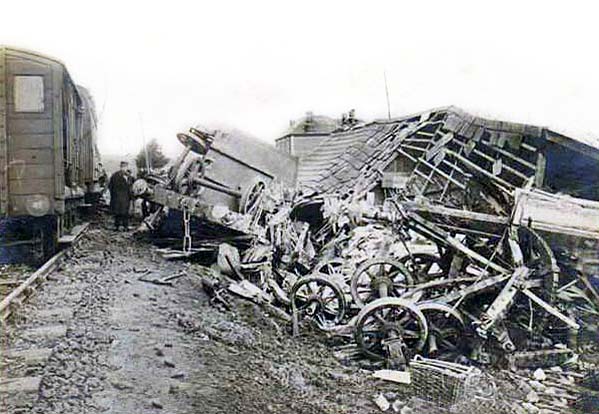 A locomotive or train, quite which is unclear, was accelerating hard away from Halwill in order to tackle the same gradient, rising in this direction, towards Ashbury. Beyond the level crossing, wrongly set points diverted the train or locomotive onto a siding whereupon it demolished the buffers and ended up on, reports say, the Beaworthy Road. Recovery involved two N15 and one S160 locomotives which required dispensation to cross Meldon Viaduct in order to attend the scene. The N15 was a 4-6-0 tender locomotive better known as the 'King Arthur’ class. The S160 was a wartime 2-8-0 of the USATC (United States Army Transportation Corp) and which saw service in many countries during and post war. Very American in appearance they were poorly designed, especially the firebox, and were prone to explode. Nevertheless many continued in service for a considerable time after the war, but not in the UK as all bar one were sent overseas following D Day. The exception was a single example retained by the army at Longmoor. The final examples in service are thought to have been on the Polish State Railways (PKP) where they survived into the late twentieth century. One 'King Arthur' survives in preservation as do a number of the S160's, including some re- imported into the UK. The gradient between Halwill and Ashbury responsible for the 1905 accident, and arguably the aforementioned 1944 accident, can be seen on the elevated views across Halwill station elsewhere in these pages. The second 1944 incident involved a locomotive overturning as a result of enemy action but no other details are known at the time of writing. Details of incidents resulting from enemy action were kept quiet, partly for morale reasons and partly to hide from the enemy any details of their successes. Such incidents would, of course, be known to local people but the public as a whole were encouraged to keep quiet. This silence was the purpose of the well known 'Careless Talk' wartime posters and cartoons but this, of course, applied generally and by no means only to 'incidents' on the railways.
Photo from John Mann collection junction_old24.jpg) A rather splendid postcard view of Halwill station from no later than July 1909, this being its postmark date. By this time all but the Torrington line had reached Halwill and the signal box will be that provided for the North Cornwall line opening but before its north end extension. Note the superb signals, mainly of wood but with iron spandrels, railings, ladder and LSWR finials. They probably related, at this time, only to the down platform and bay rather than to the North Cornwall junction. In the bay, two LSWR coaches are seen, probably 6-wheelers, while wagons can be seen at the goods shed. The most obvious wagon is of the type used for salt, sand, lime, clay etc. It appears to be sheeted rather than roofed. Several of the station’s oil lamps can be seen. The people posing for the camera are mainly, if not entirely, railway staff of various grades. It should be remembered that over a century ago many people, especially in rural areas, had never seen a camera in action so scenes such as this would have been very much memorable events. On the left, note the point rodding and signal wires disappearing beneath the platform and re-emerging from the end of the ramp. When the Torrington bay was constructed these rod-and-wire routes were covered by a wooden walkway for the benefit of drivers attending to their locomotives.
Copyright photo from John Alsop collection junction_old25.jpg) A postcard view of Halwill station looking north with the level crossing behind the camera. If it were not for the nameboard, which does not yet announce details of connections, the location would be difficult to recognise due in no small part to the bushes and trees. The postcard is postmarked July 1909 but the photograph was probably taken a little earlier. The locomotive is LSWR Adams 395 class 0-6-0 No.442, a class nicknamed 'Jumbos' (not to be confused with the Caledonian Railway locomotives of the same name). No.442 was built by Neilson, Reid & Co. in 1883 and in 1903 a Drummond 4-4-0 was built and which was also numbered 442. Thereafter 395 class No.442 went on the duplicate list as No.0442. Therefore this photograph in theory dates from no later than 1903, depending upon when the LSWR actually got around to applying the renumbering, but is probably from 1905, the year the headcode displayed on No.442 was introduced. This headcode tells us the train was a Padstow - Exeter service. The 395 class were somewhat odd looking machines owing to their raked-back smokebox fronts similar to that found on the Metropolitan and District 4-4-0T's. During WWI several members of the 395 class were sent abroad, some ending up in the Middle East where they continued in service for many years following the end of hostilities. No.442, however, remained at home. After a lengthy career of no less than 74 years she was finally withdrawn in August 1957 as British Railways No.30578. This demonstrates very well the rugged simplicity of 0-6-0 tender locomotives, many types originating in Victorian times surviving well into BR days. The group on the down platform appears to comprise mainly children. A century or more ago photography was something of an event and people posed rigid for the camera but the party on the down platform are rather blurred, suggesting lack of interest in the camera. There is probably a train due in the down direction, which would explain the signal being 'on' against No.442. Note that the signal has a quite ornate lattice post whereas signal posts at the other end of the station at this time were largely of wood. It is likely the lattice post has replaced
an earlier wooden example. Copyright photo from John Alsop collection junction_old27.jpg)
Halwill station has a 'Colonel Stephens' look about it in this view taken on a wet day in June 1926, not long after the General Strike of that year. The mixed train at the down platform comprises two passenger coaches, some goods wagons and vans, plus another passenger brake at the rear so presumably the goods vehicles are either fitted (braked) or through-piped. The locomotive is 460 class No.0471. This was one of the batch built by Robert Stephenson & Co in 1884. Another member of the class can be seen in the goods yard, this time one of the Neilson batch with Adams-style square cab windows and also dating from 1884. No.0471 will depart Halwill and branch off onto the Launceston and Wadebridge line. In the bay platform a Drummond M7 0-4-4T sits with a short goods train or perhaps in the process of forming a goods train. Assuming the headcode disc visible is the only one carried, it is the code for Bude. Also visible are the dock, goods shed and a large part of the goods yard. The yard saw a number of alterations over the years and a 50ft locomotive turntable was also provided; it is to the right of this view but largely out of sight. Note the lamp on the tall lattice post, right background. What this was fuelled by is not known but the platform lighting was certainly still oil at this time and would continue to be so for a number of years.
Copyright photo by HC Casserley 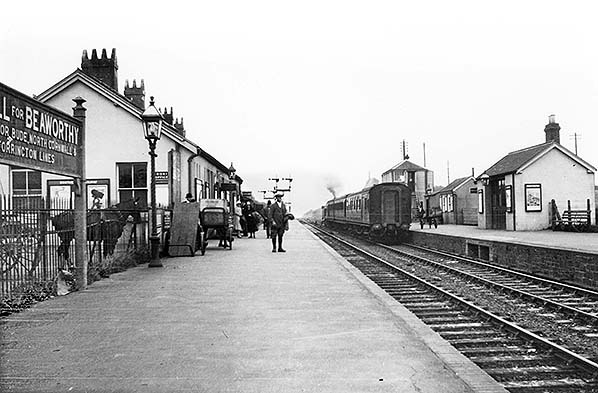 A charming scene looking north along the down platform of Halwill for Beaworthy'station in 1931. As always, the station building is neat and tidy while various Southern Railway signs and noticeboards can be seen. Oil lamps with their typical glass chimneys can be seen in the casements. Behind the railings on the left what appears to be a pony gig is seen waiting. The running-in board at far left is in its post-1925 form. Passengers are informed that they should 'Change for Bude, North Cornwall & Torrington Lines'. As many trains arriving at Halwill would have continued to one or other of the listed destinations, one wonders how many people already on a train would have been confused and alighted unnecessarily. The use of the 'North Cornwall' name is a little odd as one might have thought 'Launceston' or 'Wadebridge' to be more informative but then the line was known as the 'North Cornwall Line' throughout its life so perhaps the choice of name caused no problems, at least not for local people. The various changes of name affecting Halwill station and its signal box over the years are well known but 'Halwill for Beaworthy' was often quoted, including on maps, as 'Halwill & Beaworthy'. Regardless of how the name was presented, the station was not especially convenient for either settlement. The train at the platform comprises an ex-LSWR 2-car set strengthened with a Maunsell brake-end coach, probably a brake third. The locomotive cannot be identified and all that can be ascertained is that it is coupled smokebox-to-train. A charming scene looking north along the down platform of Halwill for Beaworthy'station in 1931. As always, the station building is neat and tidy while various Southern Railway signs and noticeboards can be seen. Oil lamps with their typical glass chimneys can be seen in the casements. Behind the railings on the left what appears to be a pony gig is seen waiting. The running-in board at far left is in its post-1925 form. Passengers are informed that they should 'Change for Bude, North Cornwall & Torrington Lines'. As many trains arriving at Halwill would have continued to one or other of the listed destinations, one wonders how many people already on a train would have been confused and alighted unnecessarily. The use of the 'North Cornwall' name is a little odd as one might have thought 'Launceston' or 'Wadebridge' to be more informative but then the line was known as the 'North Cornwall Line' throughout its life so perhaps the choice of name caused no problems, at least not for local people. The various changes of name affecting Halwill station and its signal box over the years are well known but 'Halwill for Beaworthy' was often quoted, including on maps, as 'Halwill & Beaworthy'. Regardless of how the name was presented, the station was not especially convenient for either settlement. The train at the platform comprises an ex-LSWR 2-car set strengthened with a Maunsell brake-end coach, probably a brake third. The locomotive cannot be identified and all that can be ascertained is that it is coupled smokebox-to-train.Photo from John Mann collection Click here for Halwill Gallery 2: - 1930s - April 1963
|


 When Halwill became a junction with the opening of the North Cornwall line, a new large signal box was built on the up platform which controlled the junction and the new bay platform on the down side. In the down direction, the trackwork and signalling allowed a train to depart from the down platform towards Bude at the same time as a down train departed from the down bay over the North Cornwall line. In the up direction, there was an inner home signal which allowed up trains to be signalled into the bay. The latter signal was subsequently removed, however, and all up trains then arrived in the up platform.
When Halwill became a junction with the opening of the North Cornwall line, a new large signal box was built on the up platform which controlled the junction and the new bay platform on the down side. In the down direction, the trackwork and signalling allowed a train to depart from the down platform towards Bude at the same time as a down train departed from the down bay over the North Cornwall line. In the up direction, there was an inner home signal which allowed up trains to be signalled into the bay. The latter signal was subsequently removed, however, and all up trains then arrived in the up platform.
 With the opening of the ND&CJLR in 1923, a new bay platform was added beyond the Bude end of the up platform which had no facilities at all - except for a running in board (which only ever showed Halwill) and a single bench seat. At the same time, the signal box was extended to accommodate extra levers - giving it an odd lop-sided look. The signal box now contained four single line token machines - the tokens being lowered to the platform by means of a bucket on a pulley!
With the opening of the ND&CJLR in 1923, a new bay platform was added beyond the Bude end of the up platform which had no facilities at all - except for a running in board (which only ever showed Halwill) and a single bench seat. At the same time, the signal box was extended to accommodate extra levers - giving it an odd lop-sided look. The signal box now contained four single line token machines - the tokens being lowered to the platform by means of a bucket on a pulley! 
 PASSENGER TRAINS
PASSENGER TRAINS In BR days, there were four down trains over the North Cornwall line to Padstow plus one which only ran as far as Launceston. There were eight trains a day to Bude of which two started at Halwill. In the up direction there were four trains from Padstow and one from Launceston and six from Bude. On Sundays there were two trains to Bude and one to Launceston - largely to cover Royal Mail requirements.
In BR days, there were four down trains over the North Cornwall line to Padstow plus one which only ran as far as Launceston. There were eight trains a day to Bude of which two started at Halwill. In the up direction there were four trains from Padstow and one from Launceston and six from Bude. On Sundays there were two trains to Bude and one to Launceston - largely to cover Royal Mail requirements.
 The ND&CJLR line only ever had two trains a day from Halwill to Torrington which departed at 10:38 a.m. and 6:30 p.m. On arrival at Halwill, the train - which normally consisted of a tank engine and single brake composite coach - had to reverse out of the bay platform to get to the run-round loop (which it had passed through on the way in). Having run-round its single coach, the loco backed the train into the bay platform once more ready for departure. Steam hauled trains through Halwill ceased from 1st January 1965 and the Torrington service was withdrawn on 1st March 1965. The last train through Halwill was on 1st October 1966 (a Saturday) with official closure from 3rd October.
The ND&CJLR line only ever had two trains a day from Halwill to Torrington which departed at 10:38 a.m. and 6:30 p.m. On arrival at Halwill, the train - which normally consisted of a tank engine and single brake composite coach - had to reverse out of the bay platform to get to the run-round loop (which it had passed through on the way in). Having run-round its single coach, the loco backed the train into the bay platform once more ready for departure. Steam hauled trains through Halwill ceased from 1st January 1965 and the Torrington service was withdrawn on 1st March 1965. The last train through Halwill was on 1st October 1966 (a Saturday) with official closure from 3rd October. 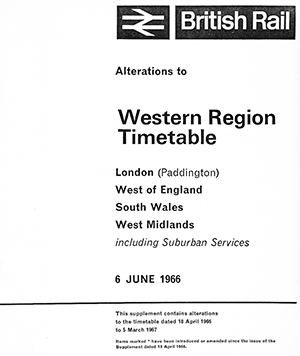 The British Railways Western Region 1966 - 67 timetable omits the lines through Halwill with even the network maps showing only bus connections for that area. The Minister of Transport consented to their closure as early as 22 December 1965, so it is assumed the timetable was produced in the confidence that the lines would close by April 1966, when the timetable came into operation. The reason for the delayed closure is not known but this situation was not uncommon and the usual reason stated was 'Delays in arranging suitable alternative bus services'. In the event BR issued a supplement which included the temporarily reprieved train services through Halwill and this is reproduced here.
The British Railways Western Region 1966 - 67 timetable omits the lines through Halwill with even the network maps showing only bus connections for that area. The Minister of Transport consented to their closure as early as 22 December 1965, so it is assumed the timetable was produced in the confidence that the lines would close by April 1966, when the timetable came into operation. The reason for the delayed closure is not known but this situation was not uncommon and the usual reason stated was 'Delays in arranging suitable alternative bus services'. In the event BR issued a supplement which included the temporarily reprieved train services through Halwill and this is reproduced here.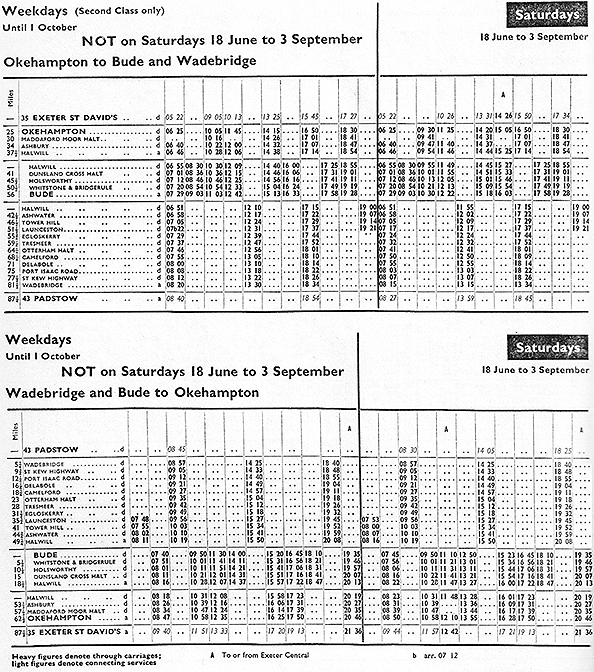
 FREIGHT
FREIGHT
 There are plans to further increase the cycle network by reopening the section east towards Meldon Junction. In 2005 Devon County Council agreed in principle to the creation of a bridleway on an intact disused section of the Bude Branch from Thorndon Cross (near the former Meldon Junction) and Halwill, a distance of approximately 7 miles. The proposal has made slow progress in the face of objections from local residents and the prohibitive prices demanded for the sale of their land by trackbed owners. In 2007 the Council again reiterated its intention to convert the disused railway to public amenity, reaffirming its intention to create cycleways on the sections from Bude to Halwill and Torrington to Halwill.
There are plans to further increase the cycle network by reopening the section east towards Meldon Junction. In 2005 Devon County Council agreed in principle to the creation of a bridleway on an intact disused section of the Bude Branch from Thorndon Cross (near the former Meldon Junction) and Halwill, a distance of approximately 7 miles. The proposal has made slow progress in the face of objections from local residents and the prohibitive prices demanded for the sale of their land by trackbed owners. In 2007 the Council again reiterated its intention to convert the disused railway to public amenity, reaffirming its intention to create cycleways on the sections from Bude to Halwill and Torrington to Halwill.
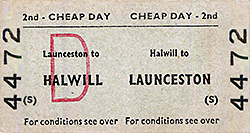
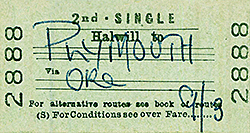

 Home Page
Home Page